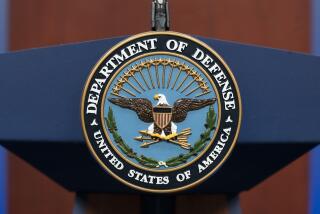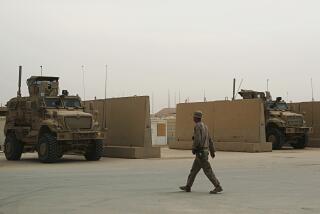Major Iraq Troop Rotation Begins
- Share via
WASHINGTON — The first of 118,000 troops left U.S. shores for Iraq this week in a massive rotation aimed at relieving war-weary soldiers and replacing them with people better equipped and trained for the job, a senior Army official said Thursday.
They include a larger component of military police and civil affairs troops compared with the combat-oriented units they are replacing, as well as lighter equipment, all designed to better carry out the stabilization mission in the still violent country.
The Army also hopes to improve the safety of the incoming troops with a new unit of up to 300 explosives experts trained to prevent the type of roadside bombings that continue to kill and maim coalition soldiers.
The rotation officially began when advance teams from the 3rd Armored Division flew to Baghdad to begin taking over command of ground forces from troops currently there, the senior official said.
Also this week, Navy ships left with equipment for the 1st Cavalry Division from Ft. Hood, Texas and the 25th Infantry Division from Hawaii.
In all, about 118,000 troops will deploy to Iraq between now and May.
Other units preparing to head to the country include elements of a Marine expeditionary force; the 1st Infantry Division from Germany; and three National Guard combat brigades, from Arkansas, Washington and North Carolina.
A fourth Army division will rotate into Afghanistan.
Returning home are about 130,000 troops from the Army’s 82nd Airborne Division from Ft. Bragg, N.C., the 3rd Armored Cavalry Regiment from Ft. Carson, Colo; the 1st Armored Division from Germany; the 4th Infantry Division from Ft. Hood; and the 101st Airborne Division from Ft. Campbell, Ky.
The troops coming and going total more than half the Army’s approved strength of 481,000 active and reserve forces.
They will be transported on ships and planes along with tens of thousands of pieces of equipment
The plans include overlaps of some weeks so that each arriving unit can work alongside the departing unit and be briefed on terrain, culture and the nature of the enemy in their region.
The rotation of people will be accompanied by a change in equipment to better fight an insurgency rather than organized military units, the Army said.
There will be fewer heavy M1A1 Abrams tanks and Bradley fighting vehicles but more lighter-armored Humvees, which are intended to protect against rocket-propelled grenades or roadside bombs, officials said.
Units bound for Iraq that are accustomed to working with heavy armor and artillery will instead be driving lighter mechanized vehicles, which they recently have been retrained to handle, the official said.
By May, only a third of the vehicles the Army has in Iraq will be tanks and other heavy armor.
The Pentagon is also sending in significantly more unmanned aerial vehicles.
“We’ve bumped up a lot of the reconnaissance capability,” the senior official said.
The newly created explosives unit is to grow to about 300 people by summer, the official said.
Experts from the unit will fan out to every command in Iraq to share techniques for detecting and defusing improvised explosive devices, which insurgents in Iraq have consistently used against U.S. and other coalition forces.
More to Read
Sign up for Essential California
The most important California stories and recommendations in your inbox every morning.
You may occasionally receive promotional content from the Los Angeles Times.










